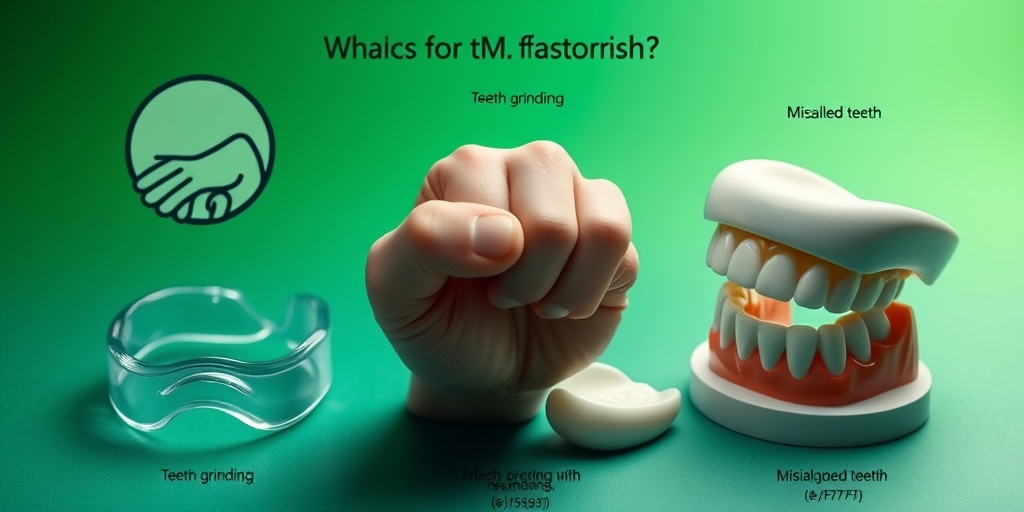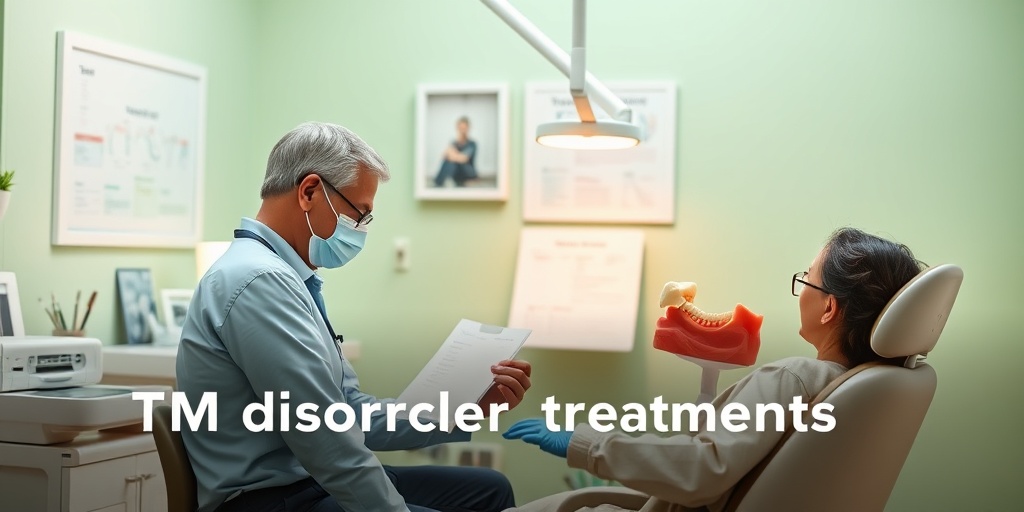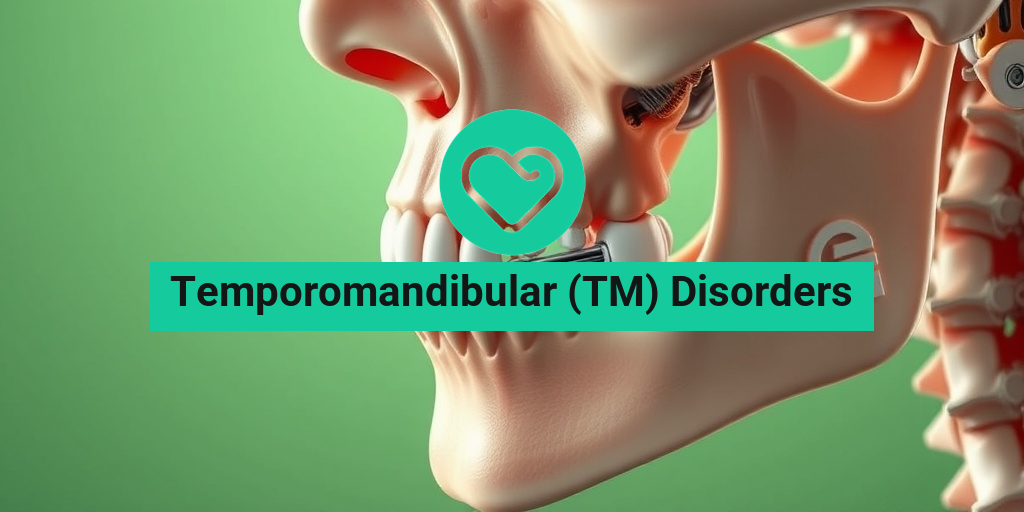What Are TM Disorders?
Temporomandibular (TM) Disorders, often referred to as TMJ disorders, are a group of conditions affecting the temporomandibular joint, which connects your jawbone to your skull. This joint is crucial for everyday activities such as chewing, speaking, and yawning. When this joint or the surrounding muscles become dysfunctional, it can lead to a variety of uncomfortable symptoms and complications.
Understanding the Temporomandibular Joint
The temporomandibular joint is a complex structure that allows for the smooth movement of the jaw. It consists of bones, cartilage, and ligaments, all working together to facilitate movement. When any part of this system is disrupted, it can lead to TM disorders. Factors contributing to these disorders can include:
- Injury: Trauma to the jaw or head can affect the joint’s functionality.
- Arthritis: Conditions like osteoarthritis or rheumatoid arthritis can lead to inflammation and pain.
- Jaw Alignment Issues: Misalignment of the teeth or jaw can put extra strain on the joint.
- Teeth Grinding: Also known as bruxism, this habit can wear down the joint and surrounding muscles.
Understanding these factors is essential for recognizing the signs and symptoms of TM disorders, which can significantly impact your quality of life.
TM Disorder Symptoms
Identifying the symptoms of TM disorders is crucial for early intervention and effective management. Symptoms can vary widely from person to person, but some common signs include:
Common Symptoms of TM Disorders
- Pain in the Jaw: This is often the most noticeable symptom. You may experience pain in the jaw joint itself or in the surrounding muscles.
- Headaches: Frequent headaches, particularly tension-type headaches, can be linked to TM disorders.
- Ear Pain: Some individuals report pain in the ears, which can be mistaken for an ear infection.
- Clicking or Popping Sounds: You may hear or feel a clicking or popping sound when moving your jaw, which can indicate joint dysfunction.
- Difficulty Chewing: Pain or discomfort while chewing can make eating a challenge.
- Locking of the Jaw: In some cases, the jaw may lock open or closed, making it difficult to move.
When to Seek Help
If you experience any of these symptoms persistently, it’s essential to consult a healthcare professional. Early diagnosis and treatment can prevent the condition from worsening and improve your overall quality of life. Resources like Yesil Health AI (yesilhealth.com) can provide evidence-based health answers and guide you in understanding your symptoms better.
Conclusion
Temporomandibular (TM) disorders can significantly impact your daily life, but understanding what they are and recognizing the symptoms is the first step toward effective management. If you suspect you have a TM disorder, don’t hesitate to seek professional advice. With the right approach, you can find relief and regain control over your jaw health. Remember, you’re not alone in this journey, and resources are available to help you navigate your symptoms. 😊

Causes of TM Disorders
Temporomandibular (TM) disorders, often referred to as TMJ disorders, can arise from a variety of factors. Understanding these causes is crucial for effective management and treatment. Here are some of the primary causes:
1. Jaw Injury
Injuries to the jaw, whether from accidents, sports, or falls, can lead to TM disorders. Such injuries may disrupt the normal functioning of the jaw joint, causing pain and discomfort.
2. Teeth Grinding and Jaw Clenching
Bruxism, or the habit of grinding teeth and clenching the jaw, is a significant contributor to TM disorders. This often occurs during sleep or in response to stress, leading to muscle fatigue and joint strain.
3. Arthritis
Arthritis, particularly osteoarthritis and rheumatoid arthritis, can affect the TM joint. Inflammation and degeneration of the joint can result in pain and limited movement.
4. Misalignment of the Jaw
Dental issues such as malocclusion (improper alignment of teeth) can place undue stress on the TM joint. This misalignment can lead to discomfort and exacerbate existing TM disorders.
5. Stress and Anxiety
Emotional stress can manifest physically, often leading to muscle tension in the jaw. This tension can contribute to the development of TM disorders, making stress management an essential aspect of treatment.
6. Other Medical Conditions
Certain medical conditions, such as fibromyalgia or chronic fatigue syndrome, can increase the likelihood of developing TM disorders. These conditions often involve widespread pain and can affect the jaw muscles and joints.
Risk Factors for TM Disorders
While anyone can develop temporomandibular disorders, certain risk factors may increase the likelihood of experiencing these issues. Understanding these factors can help in early identification and prevention.
1. Age and Gender
TM disorders are more commonly diagnosed in individuals aged 20 to 40, with women being affected more frequently than men. Hormonal differences may play a role in this disparity.
2. Previous Dental Work
Individuals who have undergone extensive dental procedures, such as braces or tooth extractions, may be at a higher risk for TM disorders. These procedures can alter the alignment of the jaw and teeth, leading to discomfort.
3. Lifestyle Factors
- High Stress Levels: Chronic stress can lead to muscle tension and jaw clenching.
- Poor Posture: Slouching or poor neck alignment can contribute to jaw strain.
- Diet: A diet high in hard or chewy foods can exacerbate TM joint issues.
4. Family History
A family history of TM disorders may increase your risk. Genetic factors can influence the structural integrity of the jaw and predispose individuals to these conditions.
5. Other Health Conditions
Individuals with conditions such as fibromyalgia, chronic headaches, or sleep disorders may be more susceptible to TM disorders. These conditions often involve muscle tension and pain, which can affect the jaw.
Recognizing the causes and risk factors associated with temporomandibular disorders is essential for effective management. If you suspect you may be experiencing TM disorders, consulting with a healthcare professional can provide guidance tailored to your specific situation. 🦷✨

Diagnosing TM Disorders
Diagnosing Temporomandibular (TM) Disorders can be a complex process, as the symptoms often overlap with other conditions. Understanding the signs and symptoms is crucial for effective diagnosis and treatment. Here’s a closer look at how healthcare professionals identify these disorders.
Common Symptoms of TM Disorders
Individuals suffering from TM disorders may experience a variety of symptoms, including:
- Pain or tenderness in the jaw, neck, or shoulders
- Clicking or popping sounds when moving the jaw
- Difficulty chewing or discomfort while eating
- Frequent headaches, especially around the temples
- Earaches or a feeling of fullness in the ears
- Jaw locking or limited jaw movement
Consultation and Physical Examination
The first step in diagnosing a TM disorder typically involves a thorough consultation with a healthcare provider. During this visit, the doctor will:
- Review your medical history and any previous dental issues.
- Ask about your symptoms, including their duration and severity.
- Perform a physical examination of your jaw and facial muscles.
During the examination, the doctor may check for jaw movement, tenderness, and any sounds produced when the jaw is opened or closed. This hands-on approach helps in identifying any abnormalities that may indicate a TM disorder.
Diagnostic Imaging
In some cases, your healthcare provider may recommend imaging tests to get a clearer picture of your jaw’s condition. Common imaging techniques include:
- X-rays: These can reveal structural issues in the jaw and teeth.
- Magnetic Resonance Imaging (MRI): This provides detailed images of the soft tissues, including the disc of the TM joint.
- Computed Tomography (CT) scans: These offer a comprehensive view of the bone structure surrounding the TM joint.
These imaging tests can help confirm a diagnosis and rule out other potential issues, such as arthritis or dental problems.
TM Disorder Treatments
Once diagnosed, the next step is to explore treatment options for Temporomandibular (TM) Disorders. Treatment plans can vary widely based on the severity of the disorder and the specific symptoms experienced by the patient. Here are some common approaches:
Conservative Treatments
Many healthcare providers recommend starting with conservative treatments, which may include:
- Physical therapy: Exercises designed to strengthen jaw muscles and improve flexibility.
- Heat or ice therapy: Applying heat or ice packs can help reduce pain and swelling.
- Medications: Over-the-counter pain relievers, such as ibuprofen or acetaminophen, can alleviate discomfort.
- Stress management: Techniques like meditation or yoga can help reduce tension in the jaw muscles.
Dental Treatments
If conservative treatments are ineffective, dental interventions may be necessary. These can include:
- Splints or mouthguards: These devices can help prevent teeth grinding and reduce pressure on the TM joint.
- Orthodontic treatment: In some cases, correcting misaligned teeth may alleviate TM disorder symptoms.
Surgical Options
In rare cases where other treatments have failed, surgical options may be considered. These can range from minimally invasive procedures to more extensive surgeries aimed at correcting structural issues within the jaw. It’s essential to discuss the risks and benefits of surgery with your healthcare provider.
Alternative Therapies
Some individuals find relief through alternative therapies, such as:
- Acupuncture: This traditional Chinese medicine technique may help relieve pain and tension.
- Chiropractic care: Adjustments may help improve jaw alignment and reduce discomfort.
While these therapies can be beneficial, it’s crucial to consult with a healthcare professional before starting any new treatment regimen.
In conclusion, diagnosing and treating Temporomandibular (TM) Disorders involves a comprehensive approach tailored to each individual’s needs. By understanding the symptoms and available treatment options, patients can work towards finding relief and improving their quality of life. 🌟

Home Remedies for TM Disorders
Temporomandibular (TM) Disorders can be uncomfortable and disruptive, but there are several home remedies that may help alleviate symptoms. These remedies focus on reducing pain, improving jaw function, and promoting relaxation. Here are some effective strategies you can try:
1. Warm and Cold Compresses
Applying heat or cold to the jaw can provide significant relief. Warm compresses help relax the muscles and improve blood flow, while cold compresses can reduce inflammation and numb pain. Try alternating between the two for optimal results. Simply apply a warm towel or an ice pack wrapped in a cloth to the affected area for 15-20 minutes at a time.
2. Gentle Jaw Exercises
Engaging in gentle jaw exercises can help improve mobility and reduce stiffness. Here are a few exercises to consider:
- Jaw Relaxation: Allow your jaw to hang loosely and breathe deeply for a few minutes.
- Side-to-Side Movement: Gently move your jaw from side to side, keeping the motion slow and controlled.
- Forward and Backward Movement: Open your mouth slightly and move your jaw forward and then back, repeating several times.
Always consult with a healthcare professional before starting any new exercise regimen, especially if you have severe symptoms.
3. Stress Management Techniques
Stress can exacerbate TM disorders, so incorporating stress management techniques into your daily routine can be beneficial. Consider practices such as:
- Meditation: Spend a few minutes each day focusing on your breath and clearing your mind.
- Yoga: Gentle yoga can help reduce overall tension in the body, including the jaw.
- Deep Breathing: Practice deep breathing exercises to promote relaxation and reduce anxiety.
4. Dietary Adjustments
What you eat can also impact your TM disorder symptoms. Opt for softer foods that require less chewing, such as:
- Mashed potatoes
- Yogurt
- Soups
- Steamed vegetables
Avoid hard, chewy, or sticky foods that can strain your jaw muscles. Staying hydrated is also essential, so drink plenty of water throughout the day! 💧
5. Over-the-Counter Pain Relief
Non-prescription medications like ibuprofen or acetaminophen can help manage pain and inflammation associated with TM disorders. Always follow the recommended dosage and consult with a healthcare provider if you have any concerns.
Living with TM Disorders
Living with Temporomandibular (TM) Disorders can be challenging, but understanding the condition and implementing effective coping strategies can make a significant difference in your quality of life. Here are some tips for managing daily life with TM disorders:
1. Educate Yourself
Knowledge is power! Understanding what TM disorders are, their symptoms, and potential triggers can help you manage your condition more effectively. Research reputable sources and consider joining support groups to connect with others who share similar experiences.
2. Maintain Good Posture
Good posture can alleviate unnecessary strain on your jaw. Be mindful of your posture while sitting, standing, and even sleeping. When using a computer or smartphone, ensure your screen is at eye level to avoid leaning forward, which can tighten jaw muscles.
3. Avoid Clenching and Grinding
Many individuals with TM disorders unconsciously clench or grind their teeth, especially during stressful situations. Being aware of this habit is the first step toward reducing it. You might also consider using a mouthguard at night to protect your teeth and relieve pressure on your jaw.
4. Regular Check-ups
Regular visits to your dentist or healthcare provider can help monitor your TM disorder and adjust treatment plans as necessary. They can provide valuable insights and recommend therapies tailored to your specific needs.
5. Seek Professional Help When Needed
If home remedies and lifestyle changes aren’t providing relief, don’t hesitate to seek professional help. Physical therapy, acupuncture, or even counseling for stress management can be effective options for managing TM disorders.
Living with TM disorders may require some adjustments, but with the right strategies and support, you can lead a fulfilling life. Remember, you’re not alone in this journey! 🌟

Frequently Asked Questions about Temporomandibular (TM) Disorders
What is a Temporomandibular Disorder (TMD)?
A Temporomandibular Disorder (TMD) refers to a group of conditions affecting the jaw joint and surrounding muscles. These disorders can cause pain, discomfort, and difficulty in jaw movement.
What are the common symptoms of TM disorders?
- Jaw pain: Discomfort in the jaw joint or surrounding muscles.
- Clicking or popping sounds: Noises when opening or closing the mouth.
- Limited jaw movement: Difficulty in fully opening or closing the mouth.
- Headaches: Frequent headaches or migraines.
- Ear pain: Discomfort or ringing in the ears.
What causes TM disorders?
TM disorders can arise from various factors, including:
- Jaw injuries: Trauma to the jaw or head.
- Teeth grinding: Also known as bruxism, which can strain the jaw muscles.
- Arthritis: Inflammation in the jaw joint.
- Stress: Increased tension can lead to muscle tightness and jaw clenching.
How are TM disorders diagnosed?
A healthcare professional typically diagnoses TM disorders through:
- Medical history: Discussing symptoms and any previous jaw issues.
- Physical examination: Checking for jaw movement and tenderness.
- Imaging tests: X-rays or MRI scans may be used to assess the jaw joint.
What treatments are available for TM disorders?
Treatment options for TM disorders may include:
- Physical therapy: Exercises to strengthen jaw muscles.
- Medications: Pain relievers or anti-inflammatory drugs.
- Stress management: Techniques such as meditation or counseling.
- Dental splints: Devices to prevent teeth grinding.
- Surgery: In severe cases, surgical intervention may be necessary.
Can TM disorders be prevented?
While not all TM disorders can be prevented, some strategies may help reduce the risk:
- Avoiding jaw clenching: Being mindful of jaw tension.
- Managing stress: Practicing relaxation techniques.
- Using proper posture: Maintaining good posture can alleviate strain on the jaw.
When should I see a doctor for TM disorders?
If you experience persistent jaw pain, difficulty in jaw movement, or any other concerning symptoms, it is advisable to consult a healthcare professional for evaluation and treatment options. 🩺




